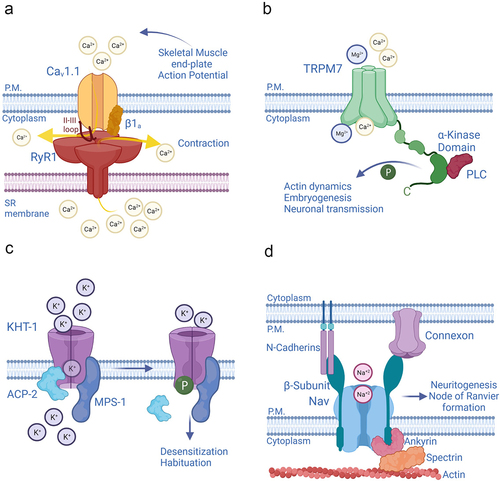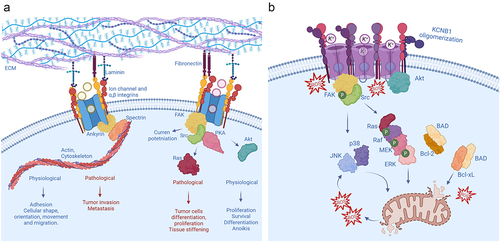Figures & data
Figure 1. Ion channels exercise non-ionic functions through multiple mechanisms (a) Channels perform non-ionic functions through physical coupling with other channels, or posses enzymatic domains in their α-subunits (b), or β-subunits (c). In addition to playing canonical regulatory roles, the β-subunits of Nav channels act as adhesion molecules that help forming cell-to-cell contacts, or link the actin cytoskeleton to the extracellular matrix, (d).

Figure 2. Non-ionic functions of integrin channel complexes (a) A widespread mechanism by which channels acquire non-ionic functions is by forming macromolecular complexes with integrins. Generally, these integrin-channel complexes regulate the shape, orientation, and movement of cells through the integrin machinery. In addition, they modulate cell proliferation, differentiation, survival and death, and are therefore implicated in a variety of oncogenic processes of different etiologies. (b) Integrin-α5-KCNB1 complexes operate in the neurons of the brain (for simplicity the ECM is not depicted). Under conditions of oxidative stress, the KCNB1 channels form oligomers that trigger apoptosis. The molecular steps underlying this process include the engagement of FAK and Src by the integrins, followed by the activation of a canonical Ras-MAPK cascade. Killer kinases, such as JNK and p38 and caspases execute the apoptotic program. At the same time, these IKCs neutralize a major mechanism of cell survival by sequestering Akt, that cannot be activated (phosphorylated) and released into the cytoplasm, to phosphorylate its multiple substrates including BAD.

